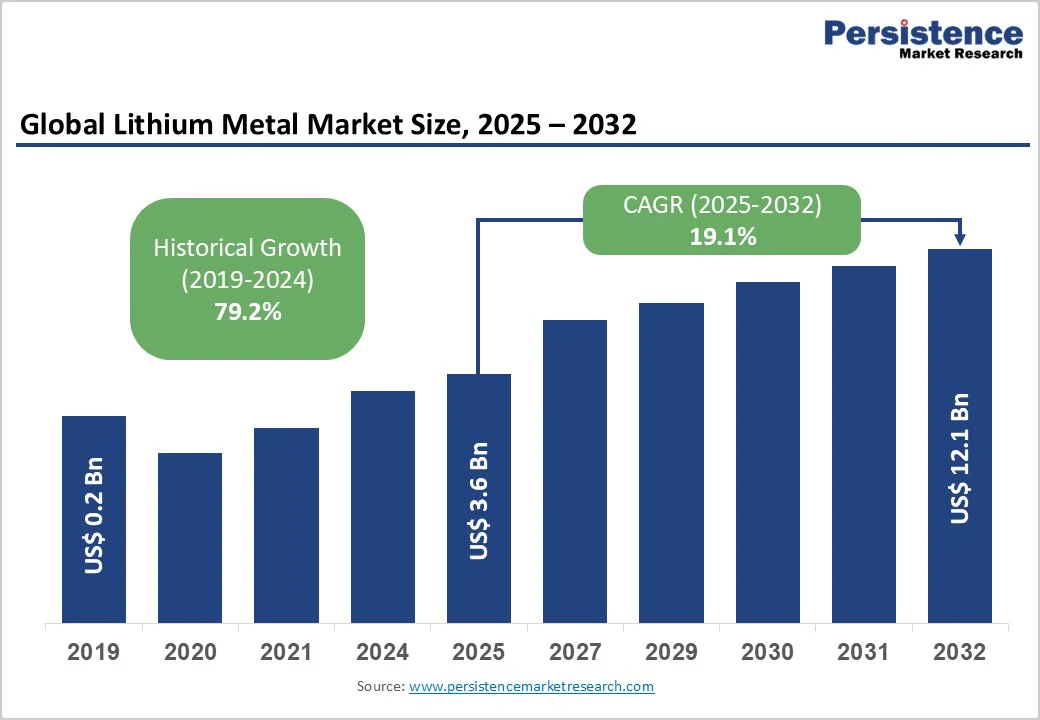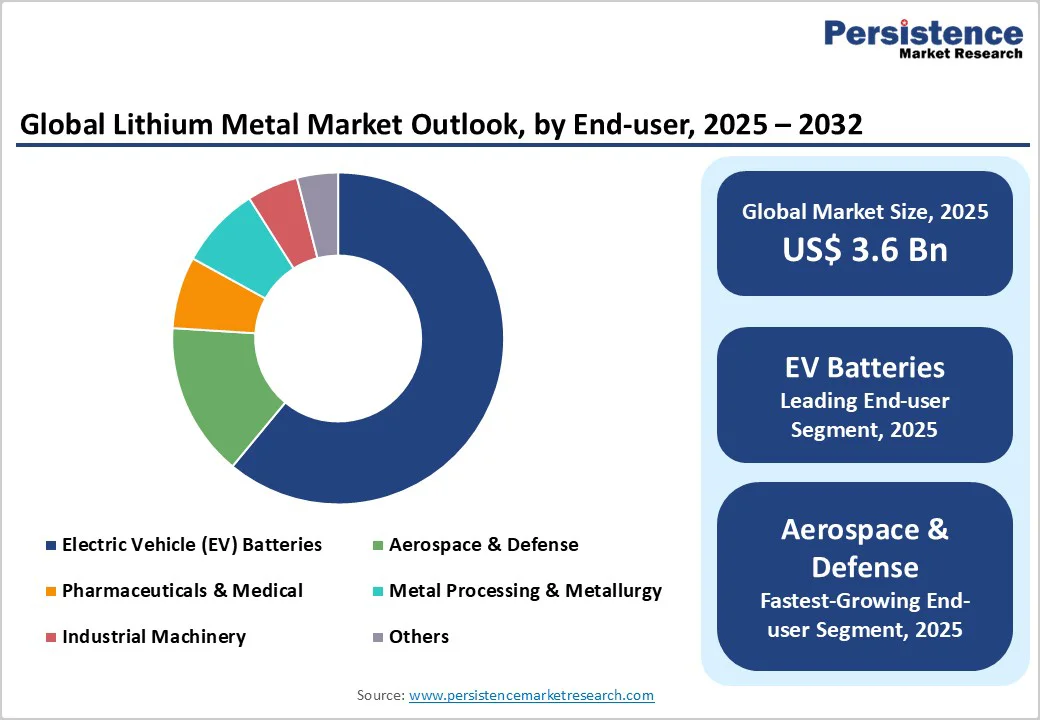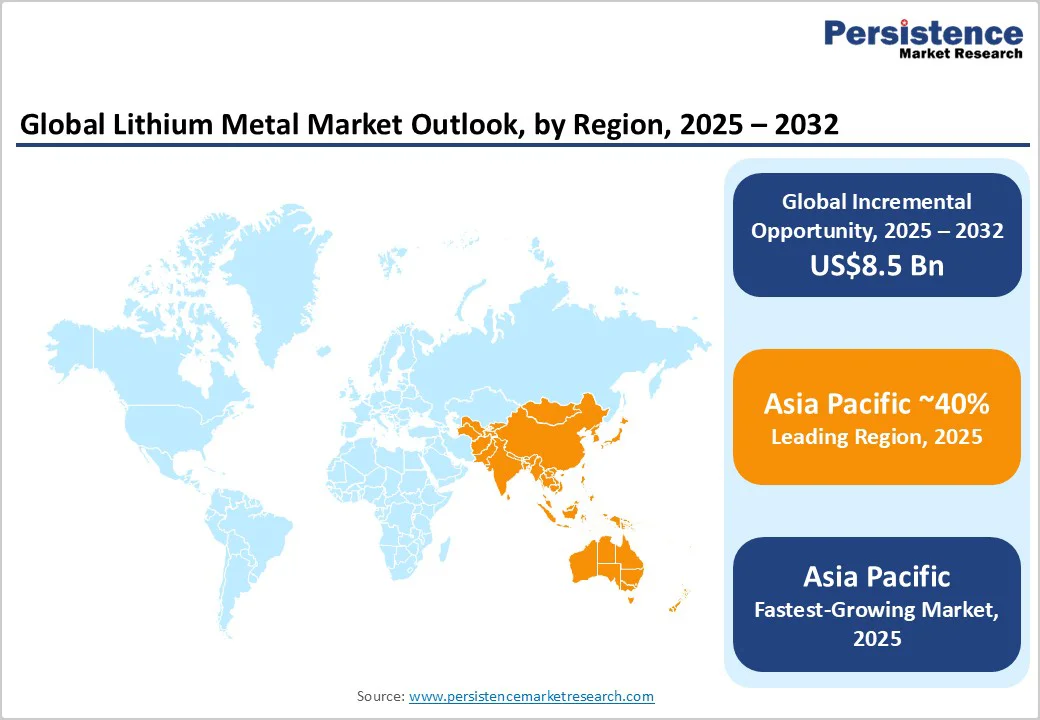ID: PMRREP35865| 219 Pages | 20 Nov 2025 | Format: PDF, Excel, PPT* | Chemicals and Materials

The global lithium metal market size is likely to be valued at US$3.6 Billion in 2025, and is estimated to reach US$12.1 Billion by 2032, growing at a CAGR of 19.1% during the forecast period 2025 - 2032, driven by the rapid electrification of the automotive industry and escalating demand for high-performance batteries.
The market’s rapid growth is fueled by surging lithium demand in EVs, energy storage, and aerospace, supported by recycling incentives and regulatory frameworks. Advances in battery chemistry and recycling are reshaping supply chains, while expanding industrial and pharmaceutical uses broaden the market. The high historical CAGR of 79.2% reflects the industry’s early-stage boom from 2019-2024, driven by soaring EV adoption and lithium-metal battery commercialization.
| Key Insights | Details |
|---|---|
| Lithium Metal Market Size (2025E) | US$3.6 Bn |
| Market Value Forecast (2032F) | US$12.1 Bn |
| Projected Growth (CAGR 2025 to 2032) | 19.1% |
| Historical Market Growth (CAGR 2019 to 2024) | 79.2% |

The rapid adoption of lithium-metal anode battery technology is a significant driver for this market. Lithium metal batteries offer superior energy density and longer cycle life compared to traditional lithium-ion batteries, making them increasingly attractive for electric vehicles and grid storage applications.
According to the U.S. Department of Energy (DOE), the energy density in lithium metal anodes is approximately five times that of graphite anodes traditionally used in lithium-ion cells, offering significant mileage extension for EVs. The International Energy Agency (IEA) data shows that the global electric car stock already exceeded 17 million in 2024, implying a considerably increased demand for high-purity lithium metal components essential for next-generation battery manufacturing.
Regulatory emphasis on reducing carbon emissions and meeting climate goals, such as the European Union (EU)’s Fit for 55 package, drives governments and original equipment manufacturers (OEMs) to quicken the adoption of energy-efficient battery solutions, thus propelling the market growth. These factors, combined with breakthroughs in solid-state battery commercialization, position lithium metal as a critical raw material for future energy systems development.
The lithium metal market faces significant structural challenges due to its complex production process involving electrolysis of lithium chloride and demand for high-purity materials.
Manufacturing lithium metal requires stringent quality control and advanced handling protocols to manage its high reactivity and flammability, resulting in elevated capital expenditures and operational costs. According to industry data from the U.S. Geological Survey (USGS) and market analysts, production costs for lithium metal remain 20-30% higher than those for lithium compounds such as lithium hydroxide or carbonate.
This cost disparity limits lithium metal’s price competitiveness, especially when raw material supply is concentrated in brine-rich regions such as the Lithium Triangle of South America.
Stringent environmental regulations governing mining and chemical extraction processes, particularly in the EU and North America, impose additional compliance costs and extend lead times. These supply chain and cost barriers pose risks to scaling production volumes rapidly enough to meet growing demand, potentially constraining market growth in the short to medium term.
The intensifying global focus on sustainability and circular economy principles presents a lucrative opportunity for lithium metal recycling technologies.
Regulatory frameworks such as the EU Batteries Directive and proposed U.S. federal incentives are accelerating the adoption of recycled lithium content mandates, targeting a minimum 30% recycled material in battery manufacturing by 2032. This evolution is driven by advancements in hydrometallurgical and direct recycling technologies that significantly reduce recovery costs and environmental impact.
Companies investing in closed-loop recycling ecosystems are positioned to capture this growth, supported by increasing volumes of lithium-ion battery waste from expanding EV fleets. This shift toward circular supply chains not only mitigates raw material supply risks but also aligns with corporate environmental, social, & governance (ESG) strategies, potentially unlocking preferential access to capital and markets.
Salt lake brine remains the dominant source of lithium metal in 2025, capturing approximately 68% of the market share. The vast lithium-rich salt flats in the Lithium Triangle, Chile, Argentina, and Bolivia, continue to benefit from geologically favorable conditions and relatively low-cost extraction methods. These lakes contain high concentrations of lithium chloride, which is extracted via evaporation pond techniques that have matured over decades, providing a cost-efficient supply.
Recycled lithium is set to emerge as the fastest-growing source during the 2025 - 2032 period. Increasing regulatory mandates, including the EU Batteries Directive and US renewables policies, are compelling automakers and battery manufacturers to incorporate recycled content, driving significant technological investments.
Advanced hydrometallurgical recycling processes now recover lithium from end-of-life batteries with 60-70% efficiency, reducing reliance on virgin resources. This growth is further catalyzed by the exponential expansion of EV battery waste and the rising financial and environmental costs of conventional extraction.
Battery-grade lithium (purity ≥99.5%) accounts for nearly 80% of the market share in 2025. This segment is critical as high-purity lithium is essential for manufacturing lithium-ion batteries with superior energy density, long cycle life, and safety compliance. Mainstream lithium producers such as Albemarle and Livent are focusing on expanding their high-purity production lines to satisfy rapidly growing EV and energy storage markets.
This segment also benefits from stringent quality standards, which allow producers to command premium prices compared to lower-grade materials. Rising demand from premium EV manufacturers in North America and Europe is further supporting this premiumization trend.
Ultra-high purity lithium (≥99.99%, 5N+ grades) is likely to be the fastest-growing segment through 2032. Its primary applications include aerospace, defense, and high-tech pharmaceuticals that require extremely pure lithium for safety-critical applications.
This growth is driven by aerospace industry expansion, particularly in North America and Europe, which emphasizes performance and reliability standards. Innovative purification techniques and stricter quality regulations are pushing manufacturers to upgrade their high-purity production capacity.
In 2025, EV batteries are set to remain the dominant end-use, accounting for about 61% of the lithium metal market revenue share. The surge in EV sales, projected at over 180 million vehicles globally by 2030, continues to drive the demand for lithium.
Major automakers worldwide are committing to phasing out internal combustion engines, and expanding EV production is supported by government incentives, stricter emission standards, and advancements in battery chemistry. The adoption of lithium-metal anodes in next-generation solid-state batteries offers prospects for energy densities exceeding 500 Wh/kg, enabling longer-range EVs.
This technological shift is compelling automakers to secure high-purity lithium supplies, favoring producers with scalable, high-quality output.
Aerospace and defense applications are the fastest-growing end-use segment, with the highest CAGR. Lithium alloys, especially aluminum-lithium, are increasingly utilized in aircraft structures and engine components to reduce weight and improve fuel efficiency. This trend is driven by the aerospace industry's ongoing modernization and sustainability targets, notably in North America and Europe, with new aircraft programs incorporating advanced lithium alloys.
The high-performance requirement for ultra-pure lithium in aerospace applications, which demand extreme reliability and safety, underpins this growth. Expanding government defense budgets and strategic diversification in new materials are further catalyzing demand.

Asia Pacific is poised to dominate the lithium metal market with the highest CAGR, commanding over 40% of the global share by 2025. China remains the largest producer and consumer, backed by its massive battery manufacturing ecosystem, with significant capacity expansions already underway. Japan and South Korea are investing heavily in next-generation battery chemistries, including lithium-metal and solid-state batteries, with high purity requirements fueling regional innovation.
India’s market is experiencing rapid growth owing to supportive policies promoting EV adoption and renewable energy, supported by investment in battery manufacturing clusters. ASEAN nations, benefiting from favorable trade agreements, are emerging as processing and assembly hubs. The high CAGR for this regional market is strongly aided by manufacturing advantages, government support, and extensive supply chains.
North America is expected to command an estimated 20% market share in 2025, with the U.S. leading due to aggressive EV adoption, government incentives, and domestic supply initiatives. The U.S. Department of Energy’s investments in high-tech battery manufacturing, coupled with policies such as the Inflation Reduction Act, are pushing forward projects focused on high-purity lithium production, innovative recycling, and supply chain resilience.
The regulatory environment is constantly evolving, supporting stricter sustainability standards and incentivizing circular economy models. Companies having a presence in North America are actively engaging in strategic acquisitions and partnerships to enhance their raw material security, especially in lithium-rich regions in North America and South America. The regional market is also set to benefit from a robust innovation ecosystem, including R&D in solid-state batteries and high-purity lithium refining.
Europe is projected to grow moderately by 2025, driven by regulatory frameworks such as the EU Batteries Regulation, which mandates minimum recycled content and high environmental standards. The major EU economies of Germany, France, and the U.K. are prioritizing domestic lithium extraction and recycling capacities as part of their green policy goals. The focus of stakeholders in Europe on integrating sustainable supply chains and investing in circular economy projects is anticipated to translate into a high CAGR through 2032.
Regulatory harmonization is fostering cross-border collaborations, with significant investment flowing into lithium recycling plants and high-purity refining facilities. The EU's strategic emphasis on reducing import dependency and increasing local processing capacity unlocks opportunities for innovative recycling technologies and high-value ultra-high purity lithium production.

The global lithium metal market landscape displays a moderately concentrated structure. Livent Corporation, Albemarle, Tianqi Lithium, and Ganfeng Lithium occupy apex positions, controlling approximately 55-60% of total market revenue in 2025. These dominant firms operate through integrated supply chains encompassing mining, refining, and high-purity production, leveraging advanced technological capabilities and extensive regional assets.
Fragmentation exists in high-value niche sectors such as recycling and ultra-high purity lithium, where smaller, innovative firms are gaining ground. The high technical barriers related to safety, refining, and purity standards sustain a high entry threshold, favoring established incumbents. Strategic alliances and M&A activity continue to shape the landscape, with consolidation efforts aimed at capacity enhancement and geographic expansion.
Key Industry Developments
The global lithium metal market is projected to reach US$3.6 Billion in 2025.
Skyrocketing demand for lithium in electric vehicles, energy storage systems, and aerospace, complemented by regulatory frameworks incentivizing the use of recycled lithium, is driving the market.
The lithium metal market is poised to witness a CAGR of 19.1% from 2025 to 2032.
Rapid electrification of the automotive industry, escalating demand for high-performance batteries, technological advancements in battery chemistry and recycling transforming global supply chains are key market opportunities.
Livent Corporation, Albemarle Corporation, and Tianqi Lithium Industries Inc. are some of the key players in the lithium metal market.
| Report Attribute | Details |
|---|---|
| Historical Data/Actuals | 2019 - 2024 |
| Forecast Period | 2025 - 2032 |
| Market Analysis | Value: US$ Bn |
| Geographical Coverage |
|
| Segmental Coverage |
|
| Competitive Analysis |
|
| Report Highlights |
|
By Source
By Grade
By End-user
By Region
Delivery Timelines
For more information on this report and its delivery timelines please get in touch with our sales team.
About Author